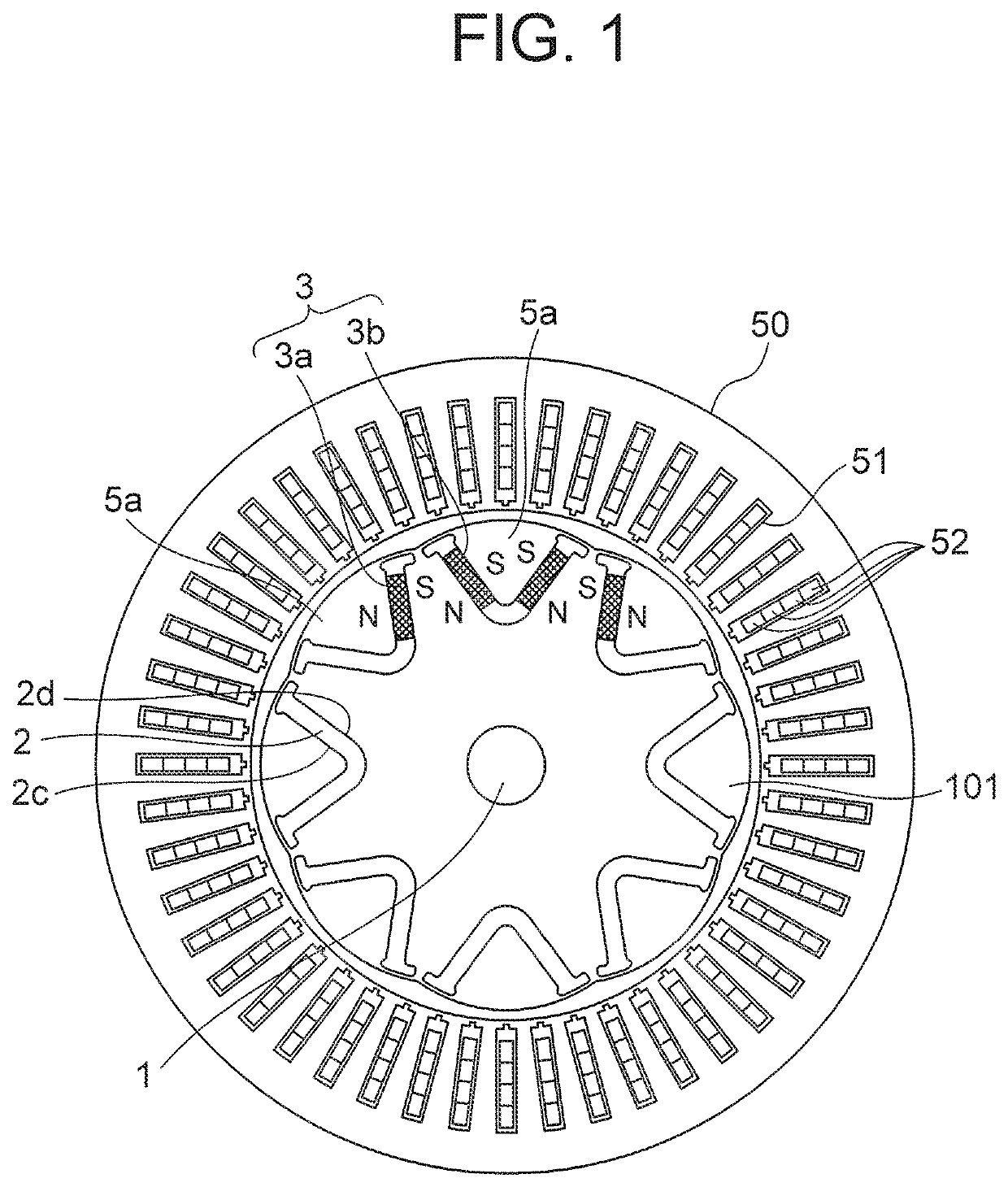Ipm rotor
a permanent magnet, rotating technology, applied in the direction of magnetic circuit rotating parts, dynamo-electric machines, magnetic circuit shape/form/construction, etc., can solve the problems of magnets being physically fragile, reluctance to use resonant torque, large generated torque, etc., to reduce the density of magnetic flux and simple structure
- Summary
- Abstract
- Description
- Claims
- Application Information
AI Technical Summary
Benefits of technology
Problems solved by technology
Method used
Image
Examples
first embodiment
[0030]FIG. 1 is a sectional view for illustrating a motor including an IPM rotor according to a first embodiment of the present invention as seen from a direction of a rotary shaft of the motor. As illustrated in FIG. 1, an IPM rotor 101 is provided around a rotary shaft 1 as a center axis.
[0031]The IPM rotor 101 has eight hole portions 2 each having a V-shape. The hole portion 2 each have outward surfaces 2c on a radially outer side of the IPM rotor and inward surfaces 2d on a radially inner side of the IPM rotor 101. One magnet 3 having a substantially rectangular parallelepiped shape is arranged on both sides of the V-shape of the hole portion 2. The magnets 3 are classified into two cases depending on a direction of a flow of magnetic flux. In one case, a magnet 3a is arranged such that a first core portion 5a as a space defined between both sides of the V-shape is set to be an N-pole. In another case, a magnet 3b is arranged such that a first core portion 5a adjacent to the fir...
second embodiment
[0072]Next, an IPM rotor 102 according to a second embodiment of the present invention is described with reference to FIG. 8 to FIG. 11. The second embodiment differs from the first embodiment in a shape of hole portions in which the the magnets are inserted.
[0073]FIG. 8 is a schematic view for illustrating the IPM rotor 102 according to the second embodiment as seen from a direction of the rotary shaft 1. In the IPM rotor 102, eight hole portions 4 each having a linear shape are formed in an arc direction of the IPM rotor 102 having a substantially circular shape. Magnets 3 to be inserted in the hole portions 4 are arranged such that N-poles and S-poles are alternately arranged along an outer side of the IPM rotor 102. Both ends of each hole portion 4 in the longitudinal direction are widened to form gaps 4a and 4b. The gaps 4a and 4b are flux barrier holes, and intend to suppress a direct flow of the magnetic flux of the magnets 3 adjacent to each other. Further, bridge portions 5...
third embodiment
[0084]Next, an IPM rotor according to a third embodiment of the present invention is described with reference to FIG. 12 and FIG. 13. In the third embodiment, protruding portions, which are configured to restrain movement in a longitudinal direction of a magnet, are arranged in a first core sheet having a spring plate portion.
[0085]In FIG. 12 and FIG. 13, there is given an enlarged illustration of only a portion of a core sheet having a substantially circular shape. Further, in FIG. 12 and FIG. 13, a state, in which the magnet 3 is inserted in each hole portion, is illustrated.
[0086]FIG. 12 is a partial plan view for illustrating a first core sheet 31. The first core sheet 31 has hole portions 31h in an arc direction. Each hole portion 31h has an outward surface 4c on a radially outer side, and an inward surface 4d on a radially inner side, of the first core sheet 31. A spring plate portion 31a is arranged to a central portion 3m of a long side of the magnet 3 in the inward surface ...
PUM
 Login to View More
Login to View More Abstract
Description
Claims
Application Information
 Login to View More
Login to View More - R&D
- Intellectual Property
- Life Sciences
- Materials
- Tech Scout
- Unparalleled Data Quality
- Higher Quality Content
- 60% Fewer Hallucinations
Browse by: Latest US Patents, China's latest patents, Technical Efficacy Thesaurus, Application Domain, Technology Topic, Popular Technical Reports.
© 2025 PatSnap. All rights reserved.Legal|Privacy policy|Modern Slavery Act Transparency Statement|Sitemap|About US| Contact US: help@patsnap.com



